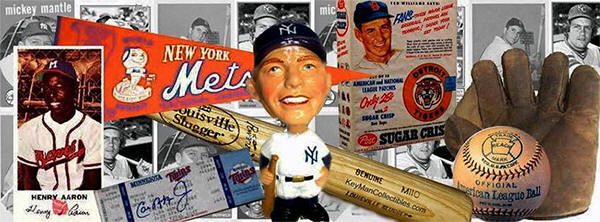|
| 1910 Spalding Catalog |
 |
| Roger Bresnahan |
|
 |
|
Roger Bresnahan |
|
 |
|
Nap Lajoie |
|
Fred Clarke's
Flip-down sunglasses |
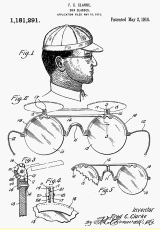 |
|
|
Rawlings Bill Doak Glove ad |
 |
|
|
Elston Howard's Training Weight Patent |
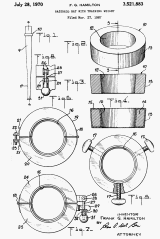 |
|
|
|
|
| KeyMan
Collectibles |
NEWSLETTER |
December 2017 |
|
|
Innovative
Baseball Players with Major
League |
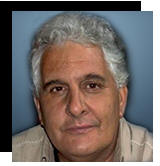 |
|
Steven KeyMan |
|
|
Experiments
& Inventions -
By Steven KeyMan |
|
Founder of
Keymancollectibles.com,
and a long time
collector, Steven
KeyMan has more than 30
years of experience in
researching, and
cataloging information
on Baseball
Memorabilia.
Researching his own personal
collection, and helping others find
information on their
collectibles, the
website grew into the
largest online resource
for baseball
memorabilia |
|
|
|
|
|
| |
Ask
Steven: Direct your questions or feedback,
about Baseball Memorabilia to Steven KeyMan
Steve@keymancollectibles.com You can also Send
KeyMan pictures of your personal Memorabilia Display,
and get your own Free
Collectors Showcase Room featured on the website.. |
|
|
|
|
There are a number of
ballplayers that left their
footprints on the game, coming up
with innovative designs & ideas
that changed the way the game is
played. Some with major impact,
others short lived with less
importance.
The first recorded instance
of any player using a baseball
glove dates to the season of 1869,
when Cincinnati Red Stockings
catcher Doug Allison first
experimented with the idea by
having a glove made for him by a
local saddle maker. At that time,
however, it was considered
“unmanly” for players to
 seek
protection for one’s hands and the
use of a glove was considered a
sign of weakness. seek
protection for one’s hands and the
use of a glove was considered a
sign of weakness.
In 1875 Charles Waite of the St. Louis Brown Stockings became the first
fielder to wear a
fingerless glove.
Unfortunately for him, he was the
subject of intense ridicule by not
only the opposing players and fans,
but by his own teammates as well.
Obviously, the timing was not right
for the widespread acceptance of
baseball gloves. It would take a
few more years, along with a
significant rule change, before the
use of gloves became accepted. The
adoption of the baseball glove by
baseball star Albert Spalding when
he began playing first base
influenced more infielders to begin
using gloves.
Modeled after a fencing mask in 1876, Fred Thayer commissioned a local
tinsmith to create the first
catchers mask. Resembling a
birdcage, the mask worn by Thayer on
April 12th, 1877, was the first to
be used in a professional baseball
game. Fred Thayer was granted a
patent on the mask n 1878, and
would officially mark
the evolution
of catchers mask. Later in the
year, A. G. Spalding and Brothers
Company, the leading American
sporting goods dealer, began
selling the Thayer Catcher's Mask
for $3. In 1883 Thayer sued
Spalding for patent infringement,
and Spalding was ultimately forced
to pay royalties.
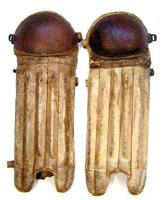
Hall of Fame Catcher Roger
Bresnahan Played
between 1897 - 1915 Bresnahan most
notable contributions to the game
were in protective equipment. In
1905 after getting "beaned" in the
head with a baseball began
experimenting with head gear
similar to the leather football
helmet of the period that were made
by A.J. Reach. Sliced vertically:
one half for covering the left side
of a right handed batter's head,
the other for the lefty hitter.
Two years later in 1907 he devised catcher's shin guards. The first,
evidently modeled after a
cricketer's leg pads but were
large, and bulky. NL president
Pulliam dismisses the Opening Day
protests of Pittsburgh manager Fred
Clarke over
Roger Bresnahan's shin
guards. As yet, Bresnahan was the
only catcher using them. Ignoring
the ridicule, it was not thought to
be gentlemanly to use them. By 1909
the design was refined, and became
accepted, and more wildly used.
Patented and first sold in 1903 by Wright & Ditson, "The Lajoie Bat" with
the double ring handle was designed
by Napoleon Lajoie. The bat was
said to offer a better grip and
improve bat control. As advertised;
"Players who want a splendidly
balanced bat, good, hard driver,
and superior bat for blocking,
bunting or hard hitting, will find
the the Lajoie will fit the bill."
The second ring on the handle was
called the shoulder. It could be
used for choking up on the bat. There were three models
available. Model No. 1 the shoulder
was 3 inches from the end, model
No. 3 was 5 inches
from the end, and the third model
No. 5 without the shoulder, had the
handle wound with tape.
the bat. There were three models
available. Model No. 1 the shoulder
was 3 inches from the end, model
No. 3 was 5 inches
from the end, and the third model
No. 5 without the shoulder, had the
handle wound with tape.
 The
flip-down sunglasses was invented
and patented in 1915 by Hall of Famer Fred
Clarke. Unlike the modern-era
flip-style, these glasses were
actually bolted into the brim of
the hat, and were of metal
construction except for the lenses.
The Fred Clarke Sun glasses were
advertised in the Spalding catalog
at $10.00 a pair, "Complete with
attachment for fastening to cap."
Clarke was the player-manager for
four of Pittsburgh’s pennants. The
flip-down sunglasses was invented
and patented in 1915 by Hall of Famer Fred
Clarke. Unlike the modern-era
flip-style, these glasses were
actually bolted into the brim of
the hat, and were of metal
construction except for the lenses.
The Fred Clarke Sun glasses were
advertised in the Spalding catalog
at $10.00 a pair, "Complete with
attachment for fastening to cap."
Clarke was the player-manager for
four of Pittsburgh’s pennants.
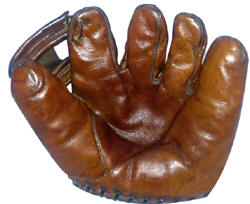
The largest improvement ever in glove design happened in 1920, when Bill
Doak, a journeyman pitcher for the
St. Louis Cardinals, approached
Rawlings with an idea for a web
laced between the first finger and
thumb. Before Doak's invention,
gloves were primarily protective
equipment that kept fielders' hands
and fingers from being hurt by hard
hit balls. Doak developed the idea
of putting a substantial webbing
between the glove's thumb and first
finger to form a substantial
pre-formed pocket in which to catch
the ball.
The Rawlings "Bill Doak"
model that was first introduced in
1920 was so revolutionary that it
remained available until 1953 with
only minor modifications. Doak's
invention was the ancestor of all
modern gloves.
 Harry
"The Hat" Walker, a National League
batting Champion with the St. Luis
Cardinals in the 1940s, developed
his own distinctive bat color
pretty much on a whim. Walker was
touring the H&B plant and noticed a
bat in a bucket of dark stain,
where it was being used as a stir
stick. Walker pulled out the bat,
and said he liked the color, and
the two-toned "Walker Finish" -
still in use today as one of H&B's
many bat finishes- was born. Harry
"The Hat" Walker, a National League
batting Champion with the St. Luis
Cardinals in the 1940s, developed
his own distinctive bat color
pretty much on a whim. Walker was
touring the H&B plant and noticed a
bat in a bucket of dark stain,
where it was being used as a stir
stick. Walker pulled out the bat,
and said he liked the color, and
the two-toned "Walker Finish" -
still in use today as one of H&B's
many bat finishes- was born.

The development of the
"Trapper" begins with Hank
Greenberg, first baseman of the
Detroit Tigers.
Hank Greenberg
concocted a mitt that looked as big
as a catchers mitt with a fishing
net attached. In 1939 Greenberg's
oversized mitt was the source of
worry, and protest. It was a
fortuitous time for Rawlings glove
designer Harry B. Latina. by 1940
he revolutionized the base mitt
with his "Trapper" design,
replacing the older "Oven Mitt"
style. In 1940 Rawlings and Latina
filed for a patent that was granted
in 1942. The glove was a hit with
players and the "Trapper model" is
born.

The Bat doughnut was created by
the New York Yankees catcher Elston
Howard. The first team to invest in
Howard's bat weight was the St.
Louis Cardinals, to essentially get
players out of the habit of
swinging multiple bats to warm up.
However Howard's invention did not make
him the
amount of money he had hoped. Other companies made their own
versions of the bat weight, and
Howard and his supporters did not
have the funds to take the
companies to court.
The Elston
Howard's On-Deck Bat Weight was
patented in 1967, approved in 1970.
|
|
|
|
|
| |
KEYMAN COLLECTIBLES
RELATED RESOURCES |
|
| |
|
|
| |
KeyMan
Collectibles Collectors Corner
- Keep up with the latest collecting news,
announcements, and articles of interest on the
webs best resource for baseball memorabilia. |
|
| |
KeyMan Collectibles Baseball
Memorabilia Facebook Group -
Post Questions and comments relating to
Baseball Collectibles and Memorabilia. Interact
with other collectors or show off your
collection. |
|
| |
KeyMan Collectibles Network54 Forum
- A great option for those that "Don't do
facebook" Post Questions and
comments relating to Baseball Collectibles and
Memorabilia |
|
|
|
|
|

